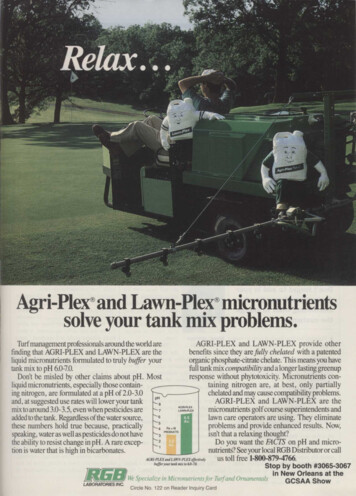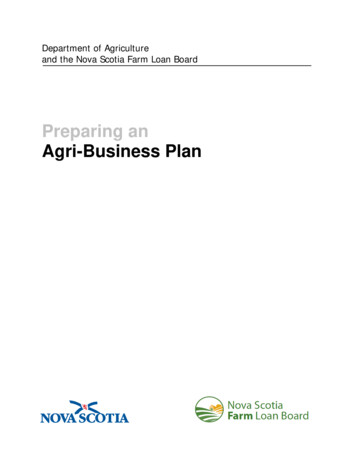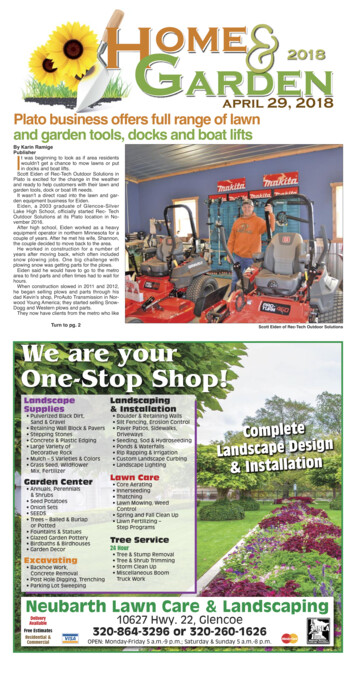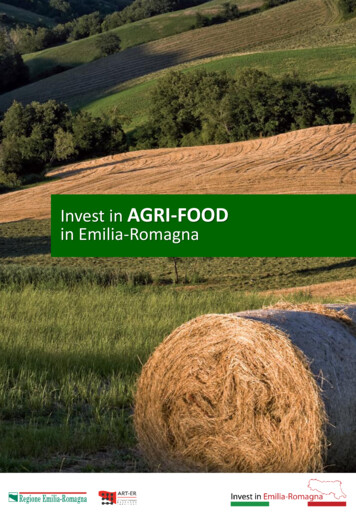
Transcription
Agri-Plex and Lawn-Plex micronutrientssolve your tank mix problems.AGRI-PLEX and LAWN-PLEX provide otherbenefits since they are fully chelated with a patentedorganic phosphate-citrate chelate. This means you havefull tank mix compatibility and a longer lasting greenupresponse without phototoxicity. Micronutrients containing nitrogen are, at best, only partiallychelated and may cause compatibility problems.AGRI-PLEX and LAWN-PLEX are themicronutrients golf course superintendents andlawn care operators are using. They eliminateproblems and provide enhanced results. Now,isn't that a relaxing thought?Do you want the FACTS on pH and micronutrients? See your local RGB Distributor or callus toll free 1-800-879-4766.AGRI-PLEX and LAWN-PLEX effectivelybuffer your tank mix to 6.0- 7.0.S t o p by b o o t h # 3 0 6 5 - 3 0 6 7yjimtmmJmmMI H E H . . We, «Specialize in.Micronutrients.for Turfand Ornamentals in N e w O r l e a n s at t h eGCSAA ShowLABORATORIES INCTurf management professionals around the world arefinding that AGRI-PLEX and LAWN-PLEX are theliquid micronutrients formulated to truly buffer yourtank mix to pH 6.0-7.0.Don't be misled by other claims about pH. Mostliquid micronutrients, especially those containing nitrogen, are formulated at a pH of 2.0-3.0and, at suggested use rates will lower your tankmix to around 3.0-3.5, even when pesticides areadded to the tank. Regardless of the water source,these numbers hold true because, practicallyspeaking, water as well as pesticides do not havethe ability to resist change in pH. A rare exception is water that is high in bicarbonates.
Are rebuilds necessary?—Once ayear or sometimes more often, you can doa 'power tune-up,' Radcliff advises. Thisconsists of simply removing the cylinderheads, cleaning out carbon, and making allthe basic adjustments to make sure theengine is performing at its maximum. Alot of rebuilds can be saved by simple,basic maintenance.Let t h e pros do it—"I don't see any reason for an untrained person to do any moreAttendance at engine seminars givescrews engine know-how.than remove the cylinder head of anengine," says Radcliff. "Taking a sump orside cover off to look inside of the enginewill usually bring more trouble than good.Engines are becoming more and more complex as time goes on. Things that even dealers have to refer to manuals about certainlyshouldn't be in the hands of someone whohasn't even read the manual. You need theunderstanding of the physics of an engine."U s e t h e s p e c i f i e d o i l — " I cannotstress it enough," Radcliff says. "(Briggs &Stratton) changed oil recommendations toa straight 30-weight as opposed to multiviscosity oil; typically you'll get much better oil consumption numbers than you dowith multi-viscosity oils. They don't burnnearly as much. With emission controlsand trying to make the engine last as longas possible, we want to make sure we usethe right oil and change it at frequentintervals.Radcliff calls wrong oil or bad oil, "Probablythe number one cause of engine death."—Terry MclverCalculatingmowing costsDon't forget to add in yourdesired profit margin whencalculating what to chargethe customer! Figuring out how much it costs to mowa given area is not entirely dependent onthe area's size, says Howard Mees ofEnvironmental Care Inc., San Diego, Calif.The service provider must also takeinto account site considerations, as well asequipment and labor costs.Site considerations include things likeareas that are too wet or over-fertilized;small, tight locations with a lot of detail;and so on. "Picking the right piece ofequipment to get optimum performance ina given location will affect production,"Mees explains. "If a 21-inch mower is usedon a five-acre park, the cost per acre ofcutting can be quite high."Here is the procedure Mees uses to calculate his mowing costs per property.E q u i p m e n t c o s t s — N o matter whatkind of mower you choose to use for par-ifMees: averagec o s t is 2 . 6 1ticular projects, youare still faced with theinitial purchase cost ofthe machine. And onceyou've made the purchase, you must spendmoney to maintainthat piece of equipment."There are not onlythe standard expensesof gas, oil and rubber goods, but also yourpreventive maintenance functions, as wellas your shop time expense," notes Mees."You also have parts, labor and downtimeexpense when your equipment is in forrepairs."There are also some hidden costs thatyou might not be figuring, says Mees.These might include: transporting the equipment to andfrom the job site; loading and unloading; time during the shift the equipmentis not in use; and/or cost of back-up equipment."The above considerations have a dollarvalue that you can attach to them," MeesMore 'extendedstorage' tips: Wash, clean and completelylubricate the mower. Touch upscratched and unpainted areas, andwipe down all metallic surfaces with amedium weight (SAE 30) motor oil toprevent rust. Drain fuel from the fuel tank.After fuel is drained, start the engineand run it until the fuel in the carburetor is exhausted. Drain and change engine oil. Clean the tires and check tirepressure. Jack up the mower so theload is off the tires. Protect mowertires from sunlight. Store in a dry and protectedplace.Source: The Bunton Co.says. "You can then see how many hoursyou actually are operating the machineand this will give you an equipment costper hour to own and operate thatmachine."Some average costs of operation—asprovided by experience, conversations withother contractors Mees talked to, andinput from manufacturers—are:gas and oil54 cents/hr.repair46 cents/hr.cost of purchase55 cents/hr.vehicle operation13 cents/hr."The average cost per hour, not allowing for the size of the equipment, is about 2.61 without profit and overhead," notesMees.O p e r a t o r costs—Next, you figure outhow much you are paying the operator perhour, including downtime and benefits.A formula for calculating this numbercan be found in the June, 1991 issue ofthis magazine, on pages 32-33. Typically,total operator costs run about 31 percentover base hourly wages. This figureincludes statutory costs like FICA andworker's comp, and voluntary costs likeinsurance, retirement and uniforms.Add together equipment costs andlabor costs per hour and you get the costper hour of mowing a particular area.This, of course, is not what you charge\O t h e r costs—The average overhead,which comes from a study done by theAssociated Landscape Contractors of
grasshopper abil'i tytuthe ability to make all the rightmoves for mowing quality and timesaving productivity.Make the move for productivity and durability withGrasshopper. Choose from the most complete line ofoutfront, zero-radius mowers in the industry, ranging from11 to 25 hp, and from 35" to 72" cutting widths. Plus a fullrange of year-round attachments including the Quik-DTatch Vac Grasscatching System. Discover GrasshopperSquare corner turnabilitySend for free literatureand name of yourGrasshopper dealer.
CALCULATING MOWING .18.19.20.DescriptionExampleSq. ft. to be mowed this propertyProduction rate (sq. ft. per hr.)aHrs. of production this property (Une 1 divided by Line 2)Cost of equipment purchaseExpected equipment life (yrs.)Hrs. mowed per yr.bEquipment life in hrs. (Line 5 times Line 6)Equipment cost per hr. (Une 4 divided by Line 7)Gas and oil cost per hr.cRepair costs per hr.cTotal equipment cost per hr. (Add Lines 8,9,10)Labor cost per hr.dOperating costs per hr. (Add Lines 11,12)Overhead per hr. (Line 13 times 0.31e)Total operating costs per hr. (Add Lines 13,14)Profit % desires1Profit per hr. (Line 15 times Line 16)Selling price per hr. (Add Lines 15,17)Total selling price this property (Line 3 times Line 18)SELLING PRICE THIS PROPERTY PER SQ. FT. (Line 19 divided by Line 2)Footnotesa . from accompanying chartb . based on 30 hrs. actual production per weekc . Howard Mees/Environmental Care researchd . approximation: see LM June, 1991 issue (apprximate hourly wage 31%)o - 0.311 is average based on Associated Landscape Contractors of America survey f - arbitrary: put your profit margin hereAmerica a few years back, is 31 percentover and above this figure. Then, add tothis the profit margin you would like tosee and you come up with a selling price."Taking these numbers further andusing an 8 per hour labor rate (includingdowntime and benefits), the cost to mowan average area per square foot is .00069(or 7/10ths of a cent)," notes Mees."To come up with some more meaningful numbers," he continues, "I looked at various data to arrive at a more complete number. This included mowing, detail work,clean-up, irrigation checks and fertilization."The range was .013 cents per squarefoot for larger, easy areas to a high of .049cents per square foot for tougher, detail-oriented sites. The average for the numbers Iran was .031 cents per square foot for turfareas needing the complete service."Mees makes one final point: in-fieldconditions are infinitely more valuablethan these overall averages when makingtrue calculations of what it costs to mow.Your worksheet120,00060,0002 12,00031,5604,680 2.57 0.48 0.44 3.49 11.00 14.49 4.49 18.980.20 3.80 22.78 41.56 .00069or.07 cents/sq. ft.How much lawn can you mow in an hour?D e c k size21"26"28"30"32"38"42"48"60"'Square feet per hour*2.5 m p h3.0 m p h3.5 m p 063,36073,920Jless than 1/2 acre (21,780 sq. ft.)J1 to 11/2 acreH1/2 to 3/4 acre (32,670 sq. ft.)J11/2 to 2 acresJ3/4 to 1 acre (43,560 sq. ft.)4.0 m p 80Source: The Ariens Co.
CONNECTICUTOHIOPorter BrothersN. Myrtle Beach, SC29597-0069800-235-7734803-399-1323Robison's Lawn andGolf, Inc.Grandview, MO 64030816-765-3333C.O. Lowe SalesColumbus, OH 43229614-771-0486SOUTH DAKOTARobison's Lawn andGolf, Inc.Springfield, MO 65807417-886-8333Garick CorporationGarfield Heights, OH 44125800-631-1395216-581-5533MISSOURICharles C. Hart Seed Co.Wethersfield, CT 06109203-529-2537Outdoor Equipment Co.Chesterfield, MO 63005314-532-6622ILLINOISTurf Products Ltd.West Chicago, IL 60185312-668-5537Shafer GroupDowners Grove, IL 60515708-852-3200INDIANAAllen County Co-opNew Haven, IN 46774219-749-5139Cannon Turf SupplyIndianapolis, IN 46220317-845-1987IOWABig Bear Turf Equip.Ca,Inc.Eldridge, IA 52748319-285-4440D & K Turf ProductsDes Moines, IA 50313515-262-9352KANSASRobison's Lawn andGolf, Inc.Witchita, KS 67209316-942-2224KENTUCKYBunton Seed CompanyLouisville, KY 40206502-583-9040MARYLANDNewsom Seed Co., Inc.Rockville, MD 20850800-553-2719301-762-2096MICHIGANTurfgrass, Inc.South Lyon, Ml 48178800-521-8873 (Ml only)313-437-1427MINNESOTANorth Star Turf, Inc.St. Paul, MN 55117612-484-8411Apex Peed & Supply, IneMarietta, OM 45750800-234-4401614-373-4401NERRASKAJohn S. Grimm, IneMedina, OH 44256800-547-1538216-725-5334Big Bear Equipment, Inc.Omaha, NE 68127800-228-9761 (Outside NE)402-331-0200Shaffer Seed & SupplyCanton, OH 44707800-543-5852216-588-9655NEW HAMPSHIRETurf Specialty, Inc.Hooksett, NH 03106800-228-6656 (Outside NH)603-485-7866Thornton-Wilson, Inc.Maineville, OH 45039800-582-6129 (Inside OH)800-543-7249 (Outside OH)513-683-2141NEW JERSEYSeacoast LaboratoriesDayton, NJ 08810201-821-4769Toledo Turf EquipmentToledo, OH 43623419-473-2503NEW YORKBanfield-Baker Corp.Horseheads, NY 14845607-739-8771OKLAHOMAOklahoma Turf & IrrigationTulsa, OK 73502918-622-8676Gro Green, Inc.Buffalo, NY 14120714-826-3300PENNSYLVANIAAllegheny Lawn ProductsWexford, PA 15090800-245-2967412-935-2290J.& L. Adikes, Inc.Jamaica, NY 11423718-739-4400Utica Seed Co.Albany, NY 12204518-434-6521Farm & Golf Course SupplyPhiladelphia, PA 19128215-483-5000NORTH CAROLINAPorter BrothersRaleigh, NC 27636800-852-4975919-851-8940AndersonsPorter BrothersShelby, NC 28150800-732-6567704-482-3424Products Divisionh P.O. Box 119 "Mauuiee, Ohio 43 371-800 225 ANDY(2639)Northampton County Seed Co.Bath, PA 18014215-837-6311SOUTH CAROLINAPorter BrothersHilton Head Island, SC 29925800-922-7947803-837-3900Dakota Turf Supply,IncorporatedSioux Falls, SD 57105605-336-1873TENNESSEETennessee OutdoorPowerLaVergne, TN 37086800-854-4851 (TN only)615-793-6052Turfaid, Inc.Memphis, TN 38107901-521-1191TEXASVan Waters & RogersDallas, TX 75355214-340-7300Van Waters & RogersHouston, TX 77210713-644-1601VIRGINIAHerod Seed CompanyRichmond, VA 23219804-643-7683WASHINGTONEnvironmentalTurf Products, Inc.Bothell, WA 98011206-488-8516WISCONSINTurf ManagementSupplySun Prairie, Wl 53590608-837-5598Wisconsin TurfEquipment Corp.Janesville, Wl 53545608-752-8766Wisconsin TurfEquipment Corp.New Berlin, Wl 53151414-544-6421Circle No. 201 on Reader Inquiry Card
Spring annualsfor the landscapeImproved annuals havemore color, uniformity anddisease resistance. Yourbiggest concern is properplant selection.by Dr. Lois Berg Stack, extensionspecialist, University of Maine In the past 40 years, since the introduction of F1 hybrids revolutionized the bedding plant industry, thousands ofimproved annual flowers have been introduced. Each year, annuals offer morecolor, greater uniformity, increased disease resistance, enhanced durability,improved growth habit and better gardenperformance.The first step in creating effective andproductive annual flower gardens is goodplant selection. Whether you are lookingfor old reliables or new introductions, youcan narrow the options by following thesefew simple rules:1. Match the plants to the environment. There are flowers for every location,wet or dry, sunny or shady—but there isno single annual that will adapt to everyenvironment.2. Choose plants that look good allseason. Some annuals stop flowering inthe heat of midsummer. Others are naturally short-lived. Annuals vary by species(petunias vs. marigolds, for example), butcultivars within a single species also vary('Apricot Brandy' vs. 'Red Fox' celosia, forexample). Where can you see annuals inreal-life situations, in order to assesswhich ones will perfom best? Visit publicgardens, check out university and commercial trial gardens, ask other landscapeprofessionals ask the greenhouse growers.(Table 1 lists some annuals that adaptwell and perform in a variety of environments, and under a broad range of culturalmanagement levels.)3. Select low-maintenance annuals."Low-maintenance" is a relative termwhen applied to annual bedding plants,since the process of planting each year is ahigh-maintenance task."Low maintenance annuals" do notrequire frequent pesticide application,deadheading (removal of old flowers toT h e s i l v e r - l e a f e d " D u s t y M i l l e r " r e q u i r e s full s u n , b u t l i t t l e m a i n t e n a n c e .T h e Zinnia elegans.Zinnias c a n bes e e d e d directly into gardens afterfrost.promote development of new ones) orother time-consuming procedures.D o n ' t s k i m p on quality—Evaluateplant quality by looking for good greencolor, lack of insect and disease problems,good flower bud count (in flowering annuals), healthy root systems, thriftiness anduniformity. When any of these traits aremissing, you may not be able to tell exactlywhat went wrong, but you know that oneor more stresses were at work. A stressedplant will never achieve its full potential,and if you can't tell what the stress was, it
will be difficult to compensate for it afterthe plants are in the landscape.Growers who produce high qualityplants can provide an extra service: theycan recommend colorful, high performance, low maintenance annuals for specific sites. They can even give you a projected maintenance schedule. Take advantage of the grower's knowledge resource.The lowest-priced annuals are notalways the best buy. Consider the relationship among quality, price and value. Ahigh-quality bedding plant is worth morethan a low quality one, because it will perform better. A high-quality plant requiresmore input (control of the productionenvironment, pest management, properfertilizer application, etc.), and hence maylegitimately cost more money. But if thatinvestment of additional cents per plantpays off in higher performance in the landscape, then the investment is a good one.Planting tips—Here are some tips forplanting annuals in the spring: Pinch back leggy seedlings at planting time. Petunias often become a bitleggy in the greenhouse. If pinched back atplanting time, they may take a bit longerto flower, but they will branch more andgive more color in the long run. If you apply a pre-emergence herbicide before planting a flower bed, rototilland rake out the bed, apply the granulesand rake in lightly. Plant the youngseedlings through the layer of soil containing herbicide granules, making sure theroot ball penetrates slightly below the herbicide layer. Many transplants suffer root20 HIGH-PERFORMANCES P R I N G A N N U A L S F O R 1992Full sun (Require minimal maintenance)Canna x generalis CCanna")Catharanthus roseus ("Periwinkle")Cleome hasslerana ("Spider a pulchella ("Annual Blanket Flower")Petunia x hydrida ("Petunia")Salvia farinacea ("Mealycup Sage")Sanvitalia procumbens ("Creeping Zinnia")Senecio cineraria ("Dusty Miller")Zinnia angustifolia ("Narrow-leaved Zinnia")Novelty plants (Have a unique appearance)Capsicum annum ("Ornamental Pepper")Ocimum basilicum ("Sweet Basil")Pelargonium species ("Scented Geraniums")Salvia virdis (no common name)Verbena x hydrida ("Verbena")'Tropical Rose/ 3 feet tall; grow from seed'Cooler' series and 'Pretty in Rose' 1.5 to 2-feetWhite, pink, lavender; 4 feetFree-flowering yellow daisy; 6 to 8 feet'Red Plume' needs deadheadingMultiflora types best for mass planting'Victoria' is 24 feet tall; vibrant blue flowersDrought-tolerant; 8-inch spreadAll of the silver-leaved variety are excellentWhite Star' the talk of 1991 trials6-12 feet plants valued for colored fruitsTry 'Spicy Globe' (10-inch mound) or'Purple Ruffles' (12-inch purple leaves)Many types, 12 to 30 inches tall; plant wherepedestrians can appreciateAn 18-inch plant with blue, pink or whitetop leaves'Peaches & Cream' is an 18-inch plant withpastel flowersShade plants (These annuals complementimpatiens gardens)Begonia x semperflorens-cultorum("Wax Begonia")Begonia x tuberhybrida ("Tuberous Begonia")Lobularia x maritima ("Sweet Alyssum")Nicotiana alata ("Flowering Tobacco")Viola x wittrockiana ("Pansy")10-12 inches tall; do well in shade; manydo well in partly sunny areas'Nonstop' and 'Nonstop Ornament' are12 to 18 inches tall; vivid warm colors4-10 inch spreading plants; sweet-scentedflowers18-30 inch upright plants; vibrant pink, white,red or green flowers8-10 inches; most newer types flower allseason, despite heatCONSIDER SOIL QUALITYSource: Dr. Lois Berg StackTemperatureTextureDrainageCONSIDERMoisture levelsNutrient levelsPHTEMPERATUREDaily fluctuationSpring and fall frost datesProximity to temperature-alteringobjects such as buildings orbodies of waterLight intensity, day length andreflectionPrecipitation: amount andregularity throughout thegrowing seasonWind and weed problemsdamage when new roots grow into the soillayer containing herbicide granules. When planting annual seedlings,remove plants from their containers even ifthe containers are peat or fiber. Until thesedegradable pots break down, they restrictyoung root growth. Be sure to cover theentire root ball with soil, particularly if theplants were grown in a peat-lite mix. Thesesoiles mixes dry out more quickly than thesurrounding native soil. Leaving the top ofthe root balls exposed at soil surface will dryout and stress young plants. For better root development, allowyoung annuals to become established for afew weeks before mulching. Do not applymulches in the spring, as they cool thesoil, which inhibits rapid plant development. Allow the seedlings to develop for afew weeks, then weed, water and mulch. Some a
Jan 21, 1992 · Apex Peed & Supply, Ine Marietta, OM 45750 800-234-4401 614-373-4401 CONNECTICUT Charles C. Hart Seed Co. Wethersfield, CT 06109 203-529-2537 MISSOURI Outdoor Equipment Co. Chesterfield, MO 63005 314-532-6622 Porter Brothers N. Myrtle Beach, SC 29597-0069 800-235-7734 803-399-1323 ILLINO











